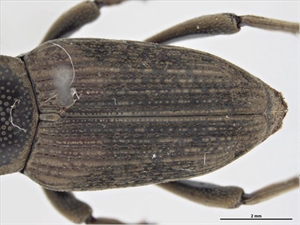- Narrow distribution. Southeast Asia, Hawaii and Oceania. On sugarcane and relatives, but also banana and palms (betel nut). An important pest.
- Eggs laid in cavities, cracks, wounds in stems and leaf bases. Larvae bore into stems, feeding on pith, causing low sugar content and stems to lodge. Tunnels allow entry of rot-causing fungi (see Fact Sheet no. 278).
- Worse since fields not burnt, and chips used as mulch.
- Spread by flying adults; in setts; in shredded leaves and stalks for mulch; and in the trade for nursery plants.
- Cultural control: use traps, or carry out random monitoring of stools; inspect setts for holes; avoid excessive N; rat control; avoid sugarcane mulches; tolerant varieties.
- Chemical control: none recommended.
Pacific Pests, Pathogens and Weeds - Online edition
Pacific Pests, Pathogens, Weeds & Pesticides
Sugarcane weevil borer (241)
Sugarcane weevil borer, New Guinea sugarcane weevil, New Guinea cane weevil borer.
Rhabdoscelus obscurus
AUTHOR Grahame Jackson
Information from CABI (2015) Rhabdoscelus obscurus (sugarcane weevil borer) Crop Protection Compendium (https://www.cabi.org/cpc/datasheet/51108); and from Halfpapp KH, Storey RI (1991) Cane weevil borer, Rhabdoscelus obscurus (Coleoptera: Curculionidae), a pest of palms in northern Queensland, Australia. Principes, 35(4):199-207. Photos 1&2 Ken Walker (2011) Cane weevil borer (Rhabdoscelus obscurus) Updated on 8/18/2011, available online. PaDIL - (http://padil.gov.au).
Produced with support from the Australian Centre for International Agricultural Research under project PC/2010/090: Strengthening integrated crop management research in the Pacific Islands in support of sustainable intensification of high-value crop production, implemented by the University of Queensland and the Secretariat of the Pacific Community.





